Procore Bundle
How Did Procore Revolutionize Construction?
Procore Technologies has become a cornerstone in the construction industry, but how did it all begin? This cloud-based construction management software platform emerged to tackle the industry's reliance on outdated methods. Founded in 2002, Procore's journey from a startup to a global leader is a compelling story of innovation and strategic growth.
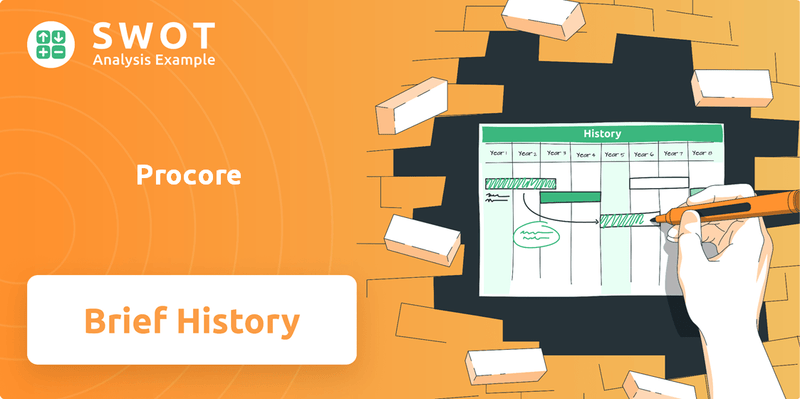
From its inception, Procore aimed to connect all construction stakeholders on a single platform, a vision that has reshaped project workflows. The Procore SWOT Analysis provides a deeper understanding of the company's strategic position. Understanding the brief history of Procore Technologies reveals how it tackled industry challenges, driving efficiency and collaboration across the globe. The company's evolution showcases its commitment to innovation and its impact on construction management.
What is the Procore Founding Story?
The story of the Procore history begins in 2002. Craig 'Tooey' Courtemanche founded the company in Carpinteria, California. His vision was to revolutionize construction project management.
Courtemanche's background in construction and technology provided the foundation for Procore. He saw the inefficiencies firsthand while building his own home. This experience fueled his mission to digitize construction management.
The Procore company started with a clear goal: to connect everyone in the construction industry. The initial focus was on a cloud-based platform. The business model was Software-as-a-Service (SaaS).
Procore was founded in 2002 by Craig 'Tooey' Courtemanche in Carpinteria, California. The company aimed to address the inefficiencies in the construction industry through technology.
- Courtemanche's experience in construction and technology was key.
- The initial challenge was to convince the industry to adopt cloud solutions.
- In 2004, Procore received $2 million in initial funding from angel investors.
- The first office was located above a surf shop.
Procore SWOT Analysis
- Complete SWOT Breakdown
- Fully Customizable
- Editable in Excel & Word
- Professional Formatting
- Investor-Ready Format
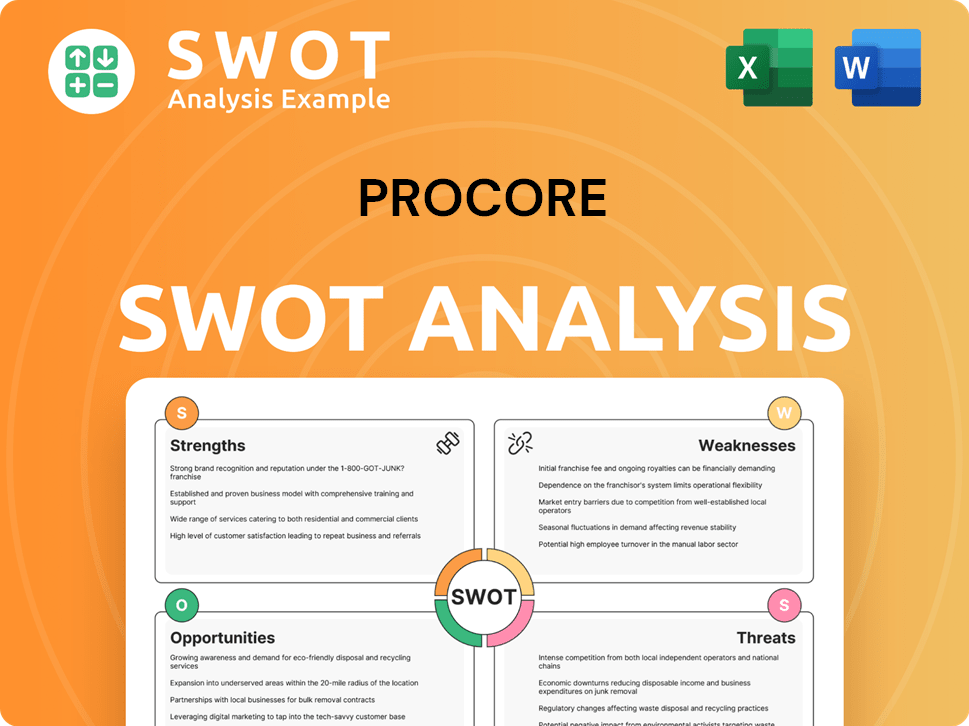
What Drove the Early Growth of Procore?
The early growth of the company, a key part of its Procore history, was marked by a customer-focused approach, especially in the largely non-digital construction sector. Although founded in 2002, significant market adoption of its online-only product didn't occur until around 2012. This timing coincided with improvements in Wi-Fi, connectivity, and the rise of smartphones and tablets. The company's strategy centered on developing solutions directly requested by customers, ensuring immediate market acceptance and a solid base before broadening its product line. This careful strategy drove a gradual shift from a single project management product to a multi-product platform serving a wide range of stakeholders.
Important early milestones included a $50 million funding round in 2016, led by Iconiq, which valued the company at over $1 billion. This was followed by additional raises of $75 million in 2018 and over $150 million in 2020. From 2007 until its IPO in 2021, the company raised nearly $500 million in total funding. Revenue grew substantially, from $4.8 million in 2012 to $400 million in 2020, showing significant growth.
The company also made strategic acquisitions to expand its offerings. These included Honest Buildings in July 2019 and Esticom in October 2020. As the company expanded, its team grew to over 4,000 employees by 2024, establishing offices globally, including in North America, Asia, and Europe. The go-to-market strategy evolved to a 'land and expand' model, where an initial entry point, such as Workforce Management, led to increased project volume and cross-selling of additional products.
The company's success is deeply rooted in its ability to adapt to the construction industry's needs. This focus helped it become a leading provider of construction management software. The company's early growth demonstrates a clear understanding of market demands and a strategic approach to scaling its business. For a deeper dive into how the company approached marketing, consider exploring the Marketing Strategy of Procore.
By 2024, the company had expanded its workforce to over 4,000 employees, reflecting its rapid growth and increasing market share. The establishment of offices across North America, Asia, and Europe highlights its global presence and commitment to serving a diverse customer base. This expansion has enabled the company to provide localized support and services, further solidifying its position in the international market.
Procore PESTLE Analysis
- Covers All 6 PESTLE Categories
- No Research Needed – Save Hours of Work
- Built by Experts, Trusted by Consultants
- Instant Download, Ready to Use
- 100% Editable, Fully Customizable
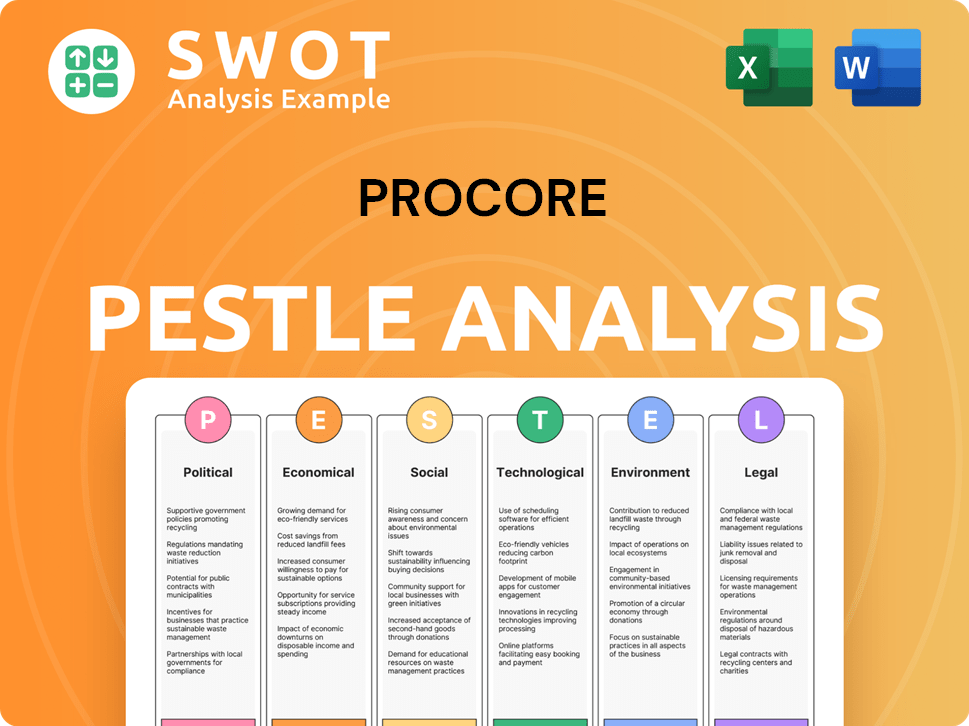
What are the key Milestones in Procore history?
The Procore company has a rich history, marked by significant milestones that have shaped its trajectory in the construction industry. A pivotal moment was the transition to a cloud-based platform, revolutionizing construction project management. This strategic move set Procore apart, driven by an understanding of construction professionals' needs.
| Year | Milestone |
|---|---|
| Early 2000s | Procore was founded with a vision to transform construction project management. |
| 2008 | Navigated the Global Financial Crisis, switching to a subscription-based SaaS model and solidifying its market position. |
| 2016-2017 | Began the transition to a multi-product company, expanding its offerings. |
| 2024 | Named to Fortune Magazine's Future 50 list, recognizing its potential for growth. |
| 2025 | Acquired Novorender for $50.5 million to enhance BIM offerings. |
Recent innovations highlight Procore's commitment to advancing construction management software. The launch of Procore AI solutions at Groundbreak 2024, featuring AI-powered tools, demonstrates its focus on automation and predictive insights.
Procore launched AI-powered Agents, Insights, and Copilot to automate tasks and improve decision-making.
Procore's Agent Studio, set to launch in 2025, will allow users to customize AI agents without coding.
Acquired Novorender in 2025 to enhance its Building Information Modeling (BIM) offerings.
Development of Procore Maps for civil customers, ensuring consistent application performance.
Development of Procore Zones for global customers, ensuring consistent application performance.
Procore has faced challenges, including the transition to a multi-product company, which took approximately 14-15 years to fully implement. The company views these challenges as opportunities for learning and continuous improvement, fostering a culture of innovation.
The move to a multi-product company required careful resource allocation and strategic decision-making.
The company's ability to navigate challenges, such as the 2008 financial crisis, has solidified its market position.
Procore's commitment to innovation is evident in its recent AI solutions and strategic acquisitions.
Procore Business Model Canvas
- Complete 9-Block Business Model Canvas
- Effortlessly Communicate Your Business Strategy
- Investor-Ready BMC Format
- 100% Editable and Customizable
- Clear and Structured Layout
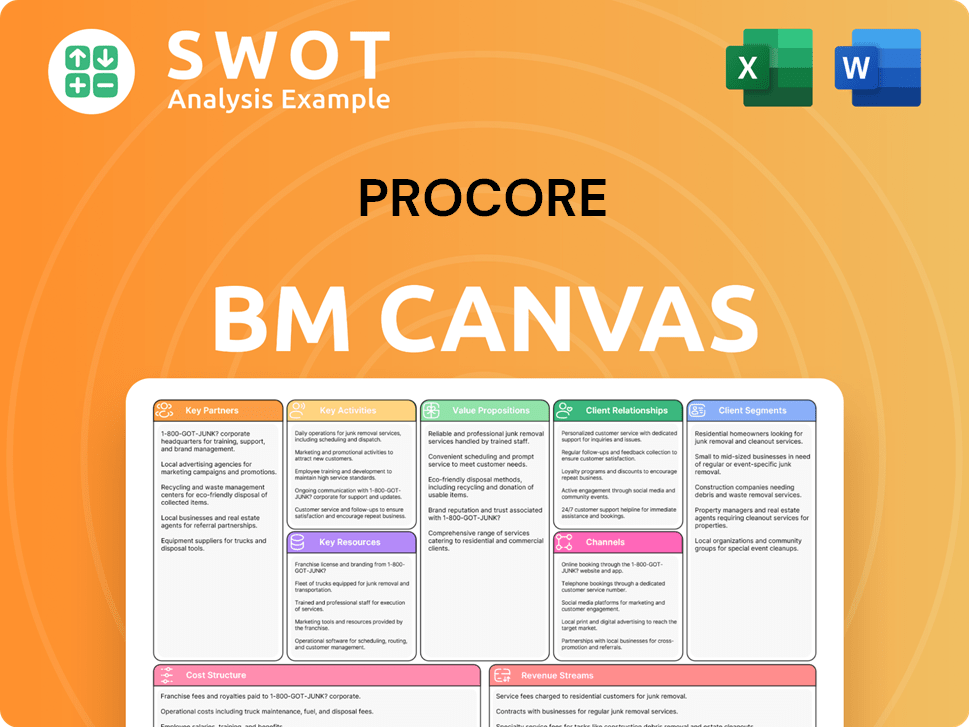
What is the Timeline of Key Events for Procore?
The Procore platform's journey showcases remarkable growth and strategic adaptation, establishing it as a leader in construction management software. Founded in 2002 by Tooey Courtemanche, the company has navigated various milestones, from initial funding rounds to a successful IPO, and has continuously evolved its product offerings to meet the industry's needs.
| Year | Key Event |
|---|---|
| 2002 | Procore Technologies was founded in Carpinteria, California, by Tooey Courtemanche. |
| 2004 | The company secured $2 million in initial angel funding, and Steve Zahm joined as President. |
| 2008 | Procore transitioned to a SaaS model, adapting to the challenges of the Global Financial Crisis. |
| 2012 | Procore gained significant market traction by advancing connectivity and mobile technology. |
| 2016 | The company raised $50 million, achieving a valuation exceeding $1 billion. |
| 2018 | Procore secured an additional $75 million in funding. |
| July 2019 | Honest Buildings, a project management software group, was acquired. |
| 2020 | Procore raised over $150 million, with revenue reaching $400 million, and acquired Esticom and Avata Intelligence. |
| May 20, 2021 | Procore went public on the NYSE under the ticker 'PCOR,' raising $634.5 million and valued at nearly $11 billion. |
| 2021 | Construction artificial intelligence company INDUS.AI was acquired. |
| 2024 (Q4) | Reported $302 million in revenue, a 16% year-over-year increase; full-year 2024 revenue reached $1.152 billion, a 21% increase. Launched Procore AI solutions at Groundbreak 2024. |
| 2025 (Q1) | Revenue increased by 15.3% to $310.63 million compared to Q1 2024. |
| 2025 (February) | Novorender was acquired for $50.5 million. |
Procore is shifting to a general manager model to enhance customer relationships and cross-sell opportunities. Full implementation of this strategy is expected by the second half of 2025. This change aims to improve customer engagement and streamline sales processes.
Analysts forecast Procore's revenue for 2025 to be between $1.289 billion and $1.290 billion. This represents a projected year-over-year growth of approximately 12%. The consistent growth indicates strong market confidence.
Procore is investing heavily in technology innovation, especially in AI-powered solutions. New AI Agents and Agent Studio are set to launch in 2025 to automate tasks and improve workflows. This focus demonstrates Procore's commitment to leveraging advanced technologies.
International expansion remains a key growth driver, with investments in global infrastructure and localized market adaptation. Procore is also focusing on empowering workforce development and integrating automation with skilled labor to increase productivity and address labor shortages. This dual approach supports both global reach and industry-specific needs.
Procore Porter's Five Forces Analysis
- Covers All 5 Competitive Forces in Detail
- Structured for Consultants, Students, and Founders
- 100% Editable in Microsoft Word & Excel
- Instant Digital Download – Use Immediately
- Compatible with Mac & PC – Fully Unlocked
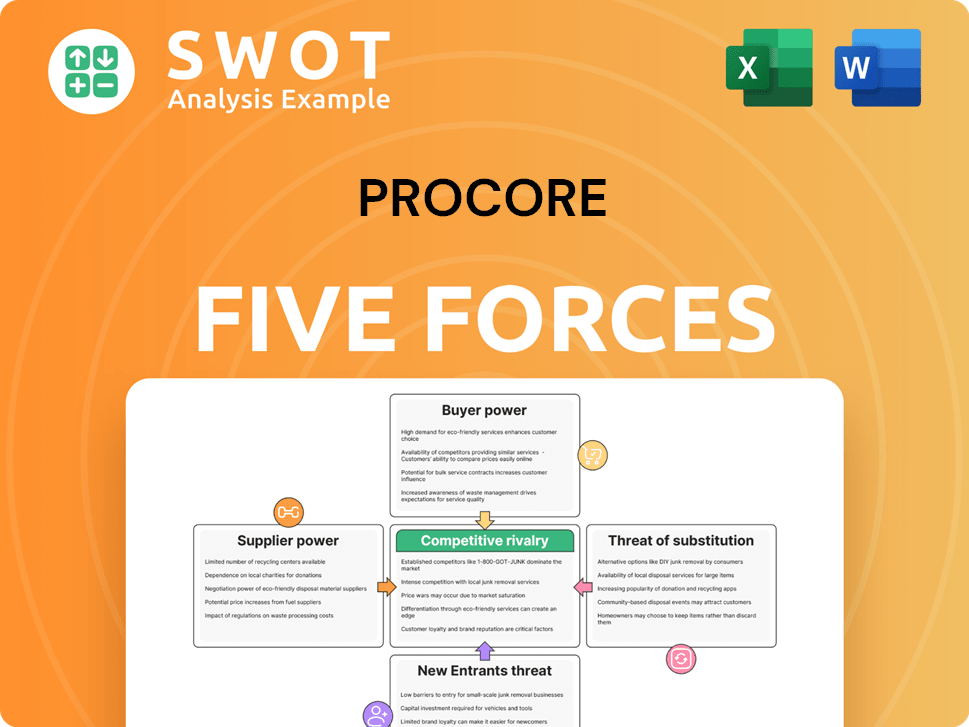
Related Blogs
- What is Competitive Landscape of Procore Company?
- What is Growth Strategy and Future Prospects of Procore Company?
- How Does Procore Company Work?
- What is Sales and Marketing Strategy of Procore Company?
- What is Brief History of Procore Company?
- Who Owns Procore Company?
- What is Customer Demographics and Target Market of Procore Company?
Disclaimer
All information, articles, and product details provided on this website are for general informational and educational purposes only. We do not claim any ownership over, nor do we intend to infringe upon, any trademarks, copyrights, logos, brand names, or other intellectual property mentioned or depicted on this site. Such intellectual property remains the property of its respective owners, and any references here are made solely for identification or informational purposes, without implying any affiliation, endorsement, or partnership.
We make no representations or warranties, express or implied, regarding the accuracy, completeness, or suitability of any content or products presented. Nothing on this website should be construed as legal, tax, investment, financial, medical, or other professional advice. In addition, no part of this site—including articles or product references—constitutes a solicitation, recommendation, endorsement, advertisement, or offer to buy or sell any securities, franchises, or other financial instruments, particularly in jurisdictions where such activity would be unlawful.
All content is of a general nature and may not address the specific circumstances of any individual or entity. It is not a substitute for professional advice or services. Any actions you take based on the information provided here are strictly at your own risk. You accept full responsibility for any decisions or outcomes arising from your use of this website and agree to release us from any liability in connection with your use of, or reliance upon, the content or products found herein.